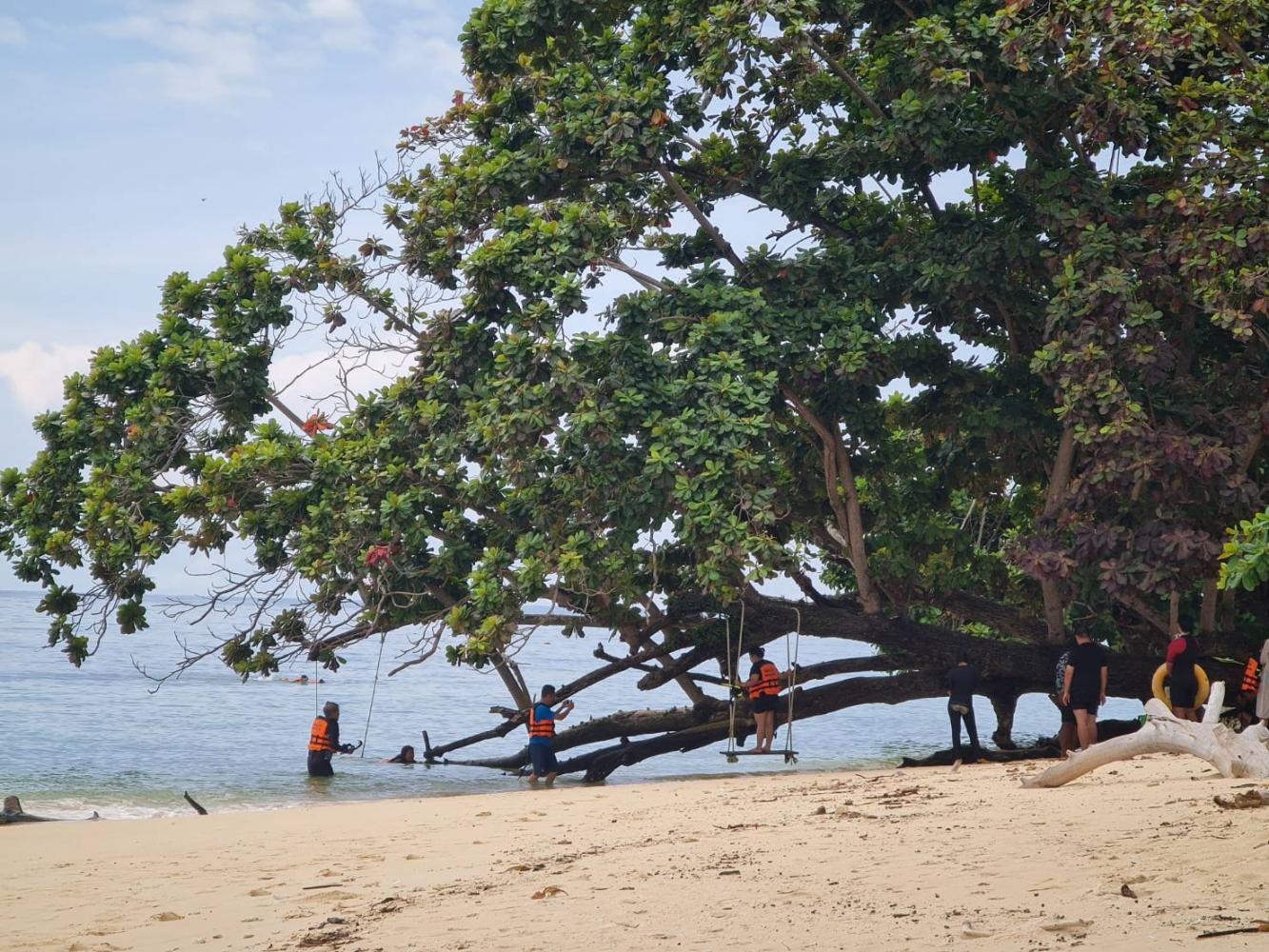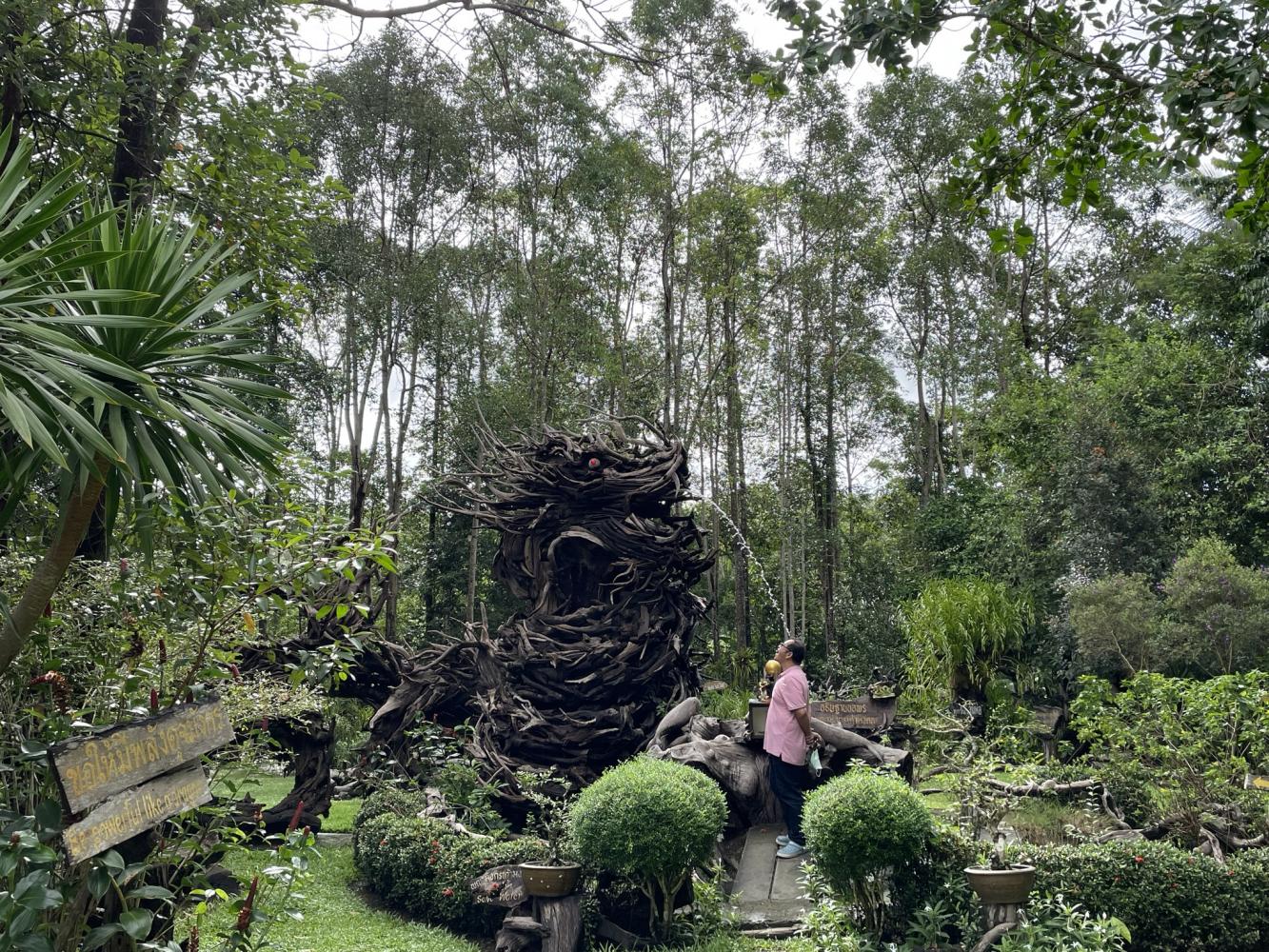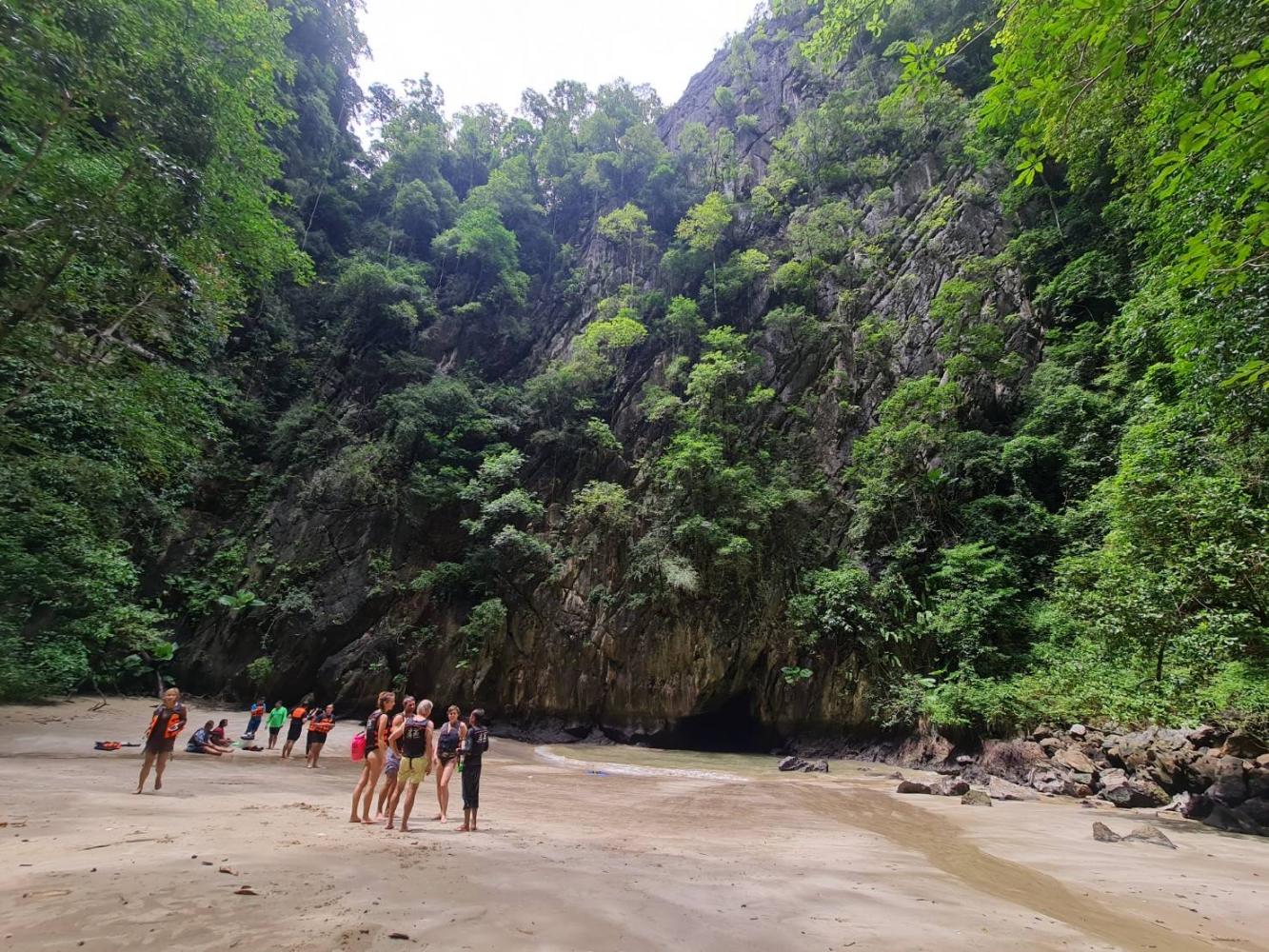After a one-hour journey from Bangkok to the southern town of Trang, the pilot announced we were landing, but our plane took off again a few minutes later. I looked out the window and spotted rain clouds forming over the airport and runway. Due to poor visibility, the pilot opted to return to Bangkok before changing his mind and landing temporarily in Krabi.
Some passengers were anxious and began haggling with cabin crew members to be allowed to disembark the plane and continue their journey by car. However, 30 minutes later, our airplane took off again and landed safely in Trang.
The sky was filled with grey stacks, and rain continued to fall over the coastal town. Our plans were thwarted, but we arrived at a train station just in time for the bell to ring, alerting us of boarding time. It's a 30km journey from downtown Trang to Kantang, a small neighbourhood that was once a major maritime harbour during the reign of King Rama V.
Passengers pay only 5 baht for a 40-minute ride and can enjoy stunning views of small villages and rubber tree plantations, making it a popular mode of transit among locals. This is the final station on the Andaman railway line, which welcomed its first passengers in 1913.
It was built with wood and painted in brown and mustard to boast a unique Panya-style architecture before going through multiple restorations to reinforce its structures. Those searching for a refreshment can find several wonderful vintage-style cafés with a selection of coffee, healthy beverages and pastries to satisfy travellers during the day.

The Kantang train station was designed in Panya style.
We transferred to a van for a sightseeing trip and drove three minutes to Ratsada Road that is home to Kantang port. It still exists at the same site and transports tourists back to a time when this area was a bustling commercial hub where sea merchants congregated and sold spices, textiles, ceramic ware and rubber from China, Europe, the Malay Peninsula, Singapore, Indonesia and the Middle East.
The walls of several old shophouses on narrow alleys have been turned into a massive canvas for colourful street art by local artists. When it's pouring outside, the Phraya Ratsadanupradit Mahison Phakdi Museum seems to be an ideal refuge for visitors to escape the rain while learning about history.
Designed in Malaysian Panya-style, Phraya Ratsadanupradit Mahison Phakdi, also known as Khaw Sim Bee Na Ranong, once lived in this 128-year-old, two-storey wood house before the Na Ranong family transformed it into a museum to showcase a collection of antique household objects from their private chamber so that young generations may learn about the way of life and Hokkien culture.
A lifelike wax figure of Phraya Ratsadanupradit Mahison Phakdi, who served as Trang governor in 1890 and brought the rubber tree to Thailand, greets guests at the welcome area. An edition of black-and-white photographs of King Rama VI and Princess Suvadhana visiting the Na Ranong family's Chakrabongse House in Penang in 1924, his family members, the first school in Trang, the Kantang Town Hall and other significant locations are displayed on the walls.
The kitchen is located behind the house and is outfitted with a large classic wood stove and a large basin to hold fresh water for cooking, while a storeroom displays a series of vintage glass and ceramic tableware, a brass cone-shaped cover and water purifier. Outside, a ditch surrounds the house, supplying water for the cultivation of vegetables, herb plants or fruits.

A frog-nosed tuk-tuk offers a sightseeing tour around Trang.


The bedrooms are on the 2nd floor and are decorated with vintage iron beds and wood furnishings to reflect the lifestyle of the Na Ranong family in the past. A corridor's walls resemble a memorial hall, with a display of rare photographs documenting Phraya Ratsadanupradit's funeral procession marching from Penang's Jakrabongse House to Swettenham Pier.
We returned to downtown Trang in the late afternoon for a quick sightseeing tour in frog-nosed tuk-tuks. Even though it was raining, the spectacular street art on the walls remained a popular picturesque setting for travellers. Scenes include rubber plantations, the Emerald Cave on Koh Mook, a clock tower, the Phraya Ratsadanupradit Mahison Phakdi monument and local life. Not far, the Tha Klang intersection is bordered with a row of ancient two-storey buildings in a mixture of Chinese and European designs that date back to 1913.
Our adventure continued the next morning to the newly opened Lung Veat Garden in Na Muen Sri subdistrict. This is a brainchild of Songkhla-born senior entrepreneur Praveat Pousuvon from the real estate industry, who wishes to create a colourful winter flower garden in the South.

Koh Kradan is a popular snorkelling spot.

"I have poured more than 19 million baht into this project to fulfil my dream. Previously, many people in the South travelled to see winter blossoms in Chiang Mai or Chiang Rai. That inspired me to build a winter botanical garden here. This will be a garden of bliss, where families can come to spend quality time together and enjoy the beauty of nature, while lovers may use it for a pre-wedding picturesque backdrop in an exotic setting," Praveat said.
Encircled with green rice fields and rubber plantations, the land is covered with a sea of vibrant marguerite daisies from both Thailand and Japan, cockscomb, cosmos, verbena or snapdragon that will be alternated throughout the year. A coffee house is nearby, offering a wide range of coffee, teas and healthy beverages that can pair with pastries for visitors to take a break during the day.
"I enjoy gardening. I've collaborated with Maejo University specialists to conduct research and breed seven-to-eight different types of winter flowers. It's difficult to grow them above 30C and on wet lands, but we've learned how to irrigate the plants to reduce summer temperatures," he explained.
"For example, the marguerite daisy takes three months to mature and blooms for 45 days. We need to know the direction of the light so that our garden will have blooms all year. We may plant orchids and lotus on the property. I want to have my garden like Singapore's Garden By the Bay."

Phraya Ratsadanupradit Mahison Phakdi's former mansion has been transformed into a museum to recount his life.




A Japanese-style garden with a waterfall and a wooden bridge on the other side is slated to completed this month. There will be a collection of attractive sculptures, a Ferris wheel and zipline, while Praveat plans to extend his flower fields from 15 rai to 58 rai in the future.
"On my land, I provide free rice growing to local villagers. This is another technique to create green zones that also function as a fence for my garden. I've currently employed 15 young local farmers to educate them about winter botanical gardening rather than cultivating rubber plants and palms," he added.
Located just 1km from the flower garden, Na Muen Sri Textile Museum exhibits more than 30 distinct native patterns that reflect the local lifestyle and customs. It's a collaboration between the Na Muen Sri Textile community and Central Group to conserve traditional handwoven techniques and highlight Thailand's attractive cultural heritage.
The intriguing exhibition takes over the 2nd floor and features a collection of antique handwoven cotton fabric in original designs, inspired by local flowers, plants and mystical creatures such as luke kaew, dok chan, kaew kulap, garuda, nok wek and a doll holding a lotus.
"Red and yellow threads were used in the Na Muen Sri cloth. Initially, we wove cloth for our loved ones or to wear on special events such as weddings and ordinations. In 2014, we developed our designs and created a line of ready-to-wear clothing for modern living. Our group now has 159 members with various skills," said Supanee Chaeychaunjit, secretary of Na Muen Sri Textile Community Enterprise.
With a 3 million baht budget, the compound houses a shop that sells a wide selection of ready-to-wear hand-woven apparel for both women and men, fashion accessories and other everyday items. The backyard has been converted into a textile weaving factory complete with eight classic wood looms, where visitors can observe how skilled housewives weave cotton in various designs to raise their income after rubber tapping.

Lung Veat Garden is quickly becoming a popular weekend destination for local families.



We were still on a trip of craftsmanship at Wang Theptaro, which is located in Huai Yot district. Retired teacher Charun Kaeola-iat has transformed his house into a 25 rai learning centre to showcase an edition of 89 dragon-like safrole sculptures and educate people about King Bhumibol's royal projects to preserve and restore Thailand's water resources, forests and soils.
He has planted over 300 fragrant safroles and has utilised their roots, seeds and leaves to produce scented wood home furnishings, essential oils, inhalers, herbal oils, insect repellents, herbal drinks and lozenges. They can help stimulate blood circulation, reduce tension, and alleviate inflammation, zoster and psoriasis.
On the last morning, we raced to Pak Meng Pier to board a huge two-storey fishing boat for a half-day cruise to Koh Kradan. This island is surrounded with several kinds of hard corals, black urchin, sea fan, brain coral, sea anemone, clownfish and parrotfish, making it a popular snorkelling spot among tourists.
Our trip came to an end at Tham Morakot (the Emerald Cave), a hidden lagoon on Koh Mook. During the low tide, the entryway is revealed and visitors can swim through a dark spiral 80m² tunnel to a small crescent-shaped beach. Its name was inspired by the turquoise waters reflected on the cave's stone walls.
TRAVEL INFO
- Phraya Ratsadanupradit Mahison Phakdi Museum is at 1 Kaipitak Road, Kantang district, Trang. It's open Tuesday to Sunday from 9am to 4pm. Admission is free.
- Lung Veat Garden, in Na Yong district, Trang, is open daily from 6am to 7pm. Tickets are 20 baht for children and 50 baht for adults. Call 096-634-8204 or visit facebook.com/suanlungveat (in Thai).
- Na Muen Sri Textile Community Enterprise is at 119, Na Muen Sri subdistrict, Trang. Call 091-162-1928.
- Wang Theptaro is at 33/1, Huai Yot district, Trang. It's open daily from 9am to 6pm. Call 089-645-0447 or visit facebook.com/wangtheptarooffice.

Na Muen Sri Textile Community has managed to maintain its unique handwoven textile skills.




Wang Theptaro displays 89 dragon-like sculptures in homage to King Bhumibol.


With a mineral-rich, crescent-like beach, Tham Morakot becomes an oasis on Koh Mook.


